Tort Law: Duty of Care and Negligence
VerifiedAdded on 2023/01/24
|9
|1989
|98
AI Summary
This document discusses the concept of duty of care and negligence in tort law. It explains the elements of negligence and how to prove a breach of duty. The document includes case studies and examples to illustrate the concepts.
Contribute Materials
Your contribution can guide someone’s learning journey. Share your
documents today.
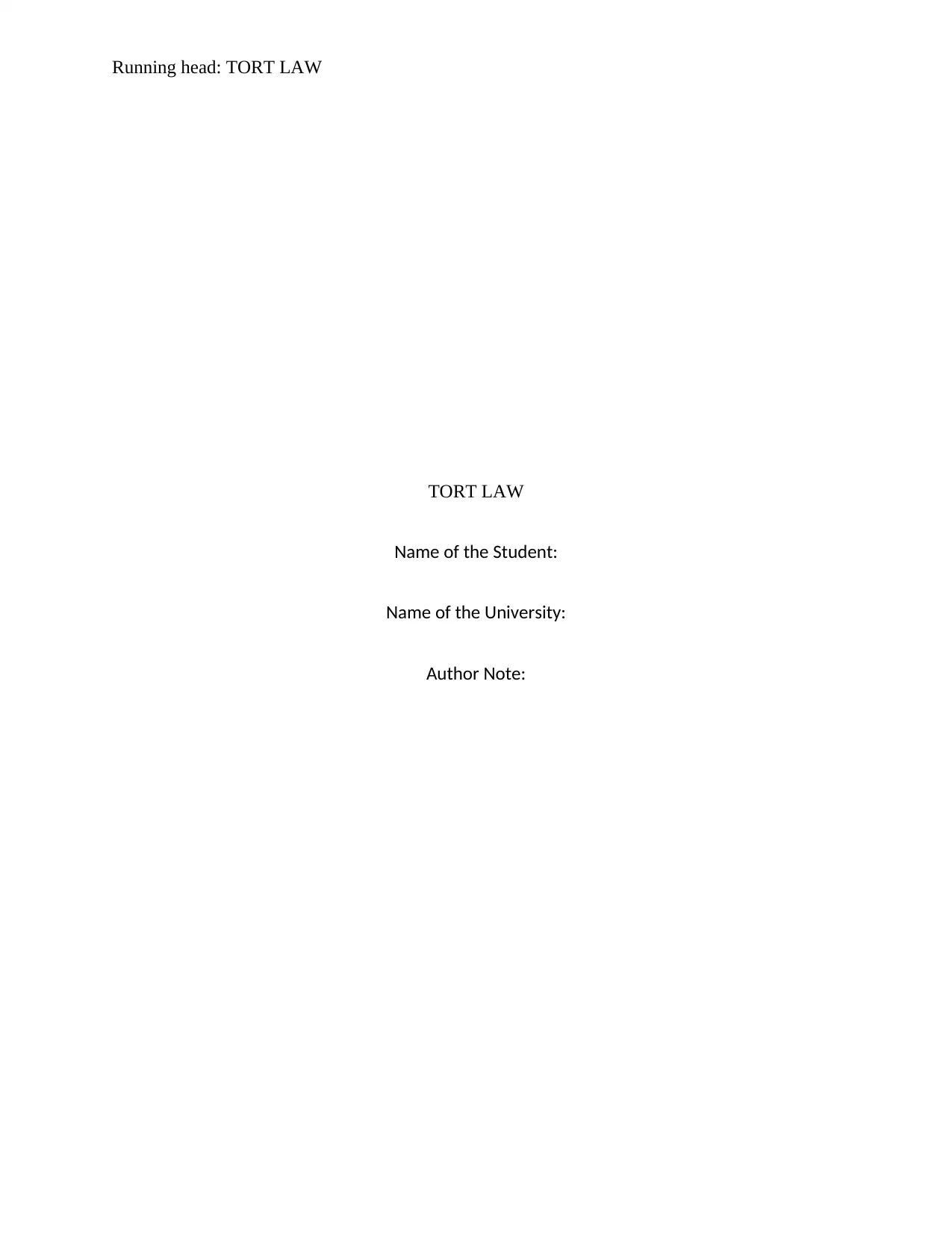
Running head: TORT LAW
TORT LAW
Name of the Student:
Name of the University:
Author Note:
TORT LAW
Name of the Student:
Name of the University:
Author Note:
Secure Best Marks with AI Grader
Need help grading? Try our AI Grader for instant feedback on your assignments.
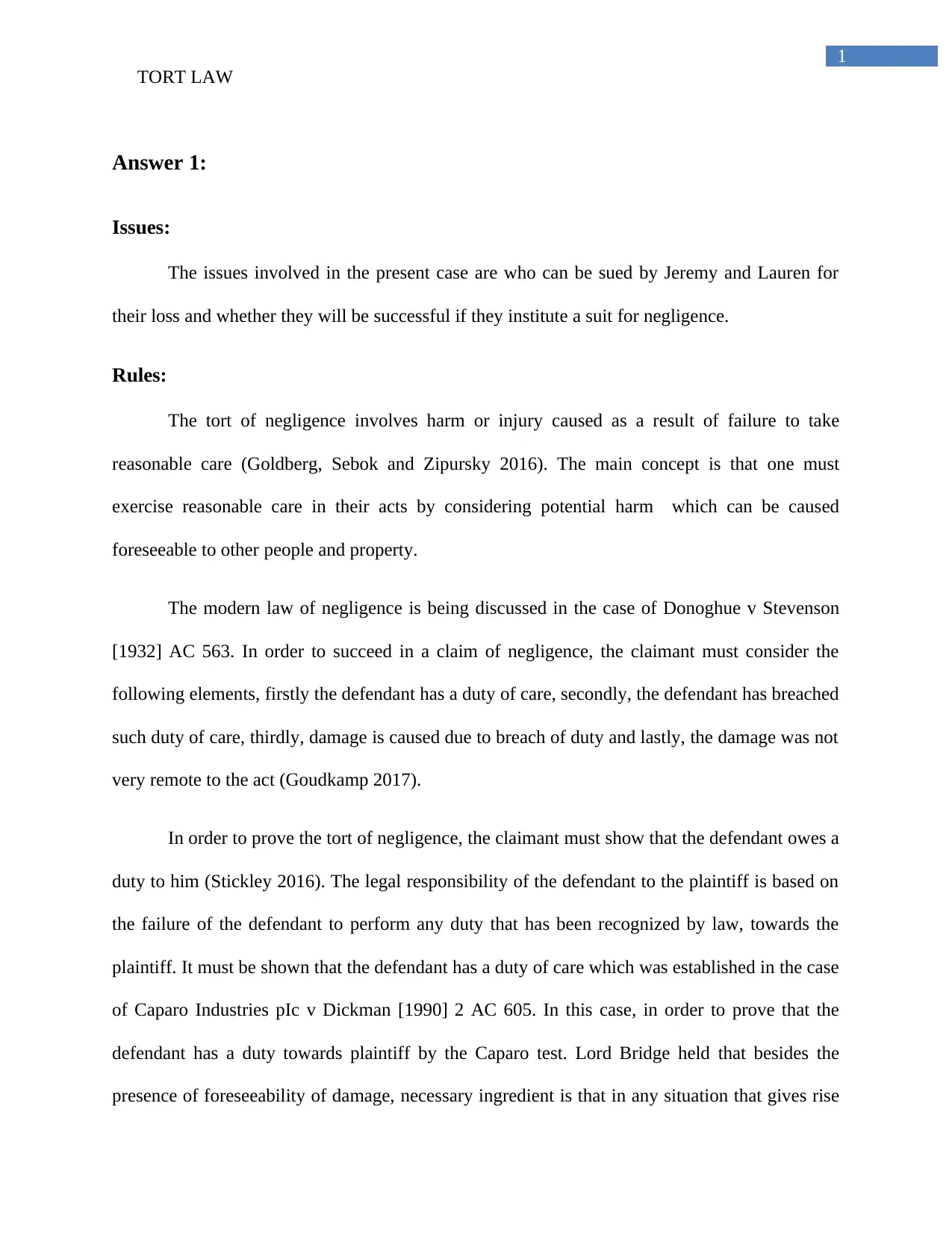
1
TORT LAW
Answer 1:
Issues:
The issues involved in the present case are who can be sued by Jeremy and Lauren for
their loss and whether they will be successful if they institute a suit for negligence.
Rules:
The tort of negligence involves harm or injury caused as a result of failure to take
reasonable care (Goldberg, Sebok and Zipursky 2016). The main concept is that one must
exercise reasonable care in their acts by considering potential harm which can be caused
foreseeable to other people and property.
The modern law of negligence is being discussed in the case of Donoghue v Stevenson
[1932] AC 563. In order to succeed in a claim of negligence, the claimant must consider the
following elements, firstly the defendant has a duty of care, secondly, the defendant has breached
such duty of care, thirdly, damage is caused due to breach of duty and lastly, the damage was not
very remote to the act (Goudkamp 2017).
In order to prove the tort of negligence, the claimant must show that the defendant owes a
duty to him (Stickley 2016). The legal responsibility of the defendant to the plaintiff is based on
the failure of the defendant to perform any duty that has been recognized by law, towards the
plaintiff. It must be shown that the defendant has a duty of care which was established in the case
of Caparo Industries pIc v Dickman [1990] 2 AC 605. In this case, in order to prove that the
defendant has a duty towards plaintiff by the Caparo test. Lord Bridge held that besides the
presence of foreseeability of damage, necessary ingredient is that in any situation that gives rise
TORT LAW
Answer 1:
Issues:
The issues involved in the present case are who can be sued by Jeremy and Lauren for
their loss and whether they will be successful if they institute a suit for negligence.
Rules:
The tort of negligence involves harm or injury caused as a result of failure to take
reasonable care (Goldberg, Sebok and Zipursky 2016). The main concept is that one must
exercise reasonable care in their acts by considering potential harm which can be caused
foreseeable to other people and property.
The modern law of negligence is being discussed in the case of Donoghue v Stevenson
[1932] AC 563. In order to succeed in a claim of negligence, the claimant must consider the
following elements, firstly the defendant has a duty of care, secondly, the defendant has breached
such duty of care, thirdly, damage is caused due to breach of duty and lastly, the damage was not
very remote to the act (Goudkamp 2017).
In order to prove the tort of negligence, the claimant must show that the defendant owes a
duty to him (Stickley 2016). The legal responsibility of the defendant to the plaintiff is based on
the failure of the defendant to perform any duty that has been recognized by law, towards the
plaintiff. It must be shown that the defendant has a duty of care which was established in the case
of Caparo Industries pIc v Dickman [1990] 2 AC 605. In this case, in order to prove that the
defendant has a duty towards plaintiff by the Caparo test. Lord Bridge held that besides the
presence of foreseeability of damage, necessary ingredient is that in any situation that gives rise
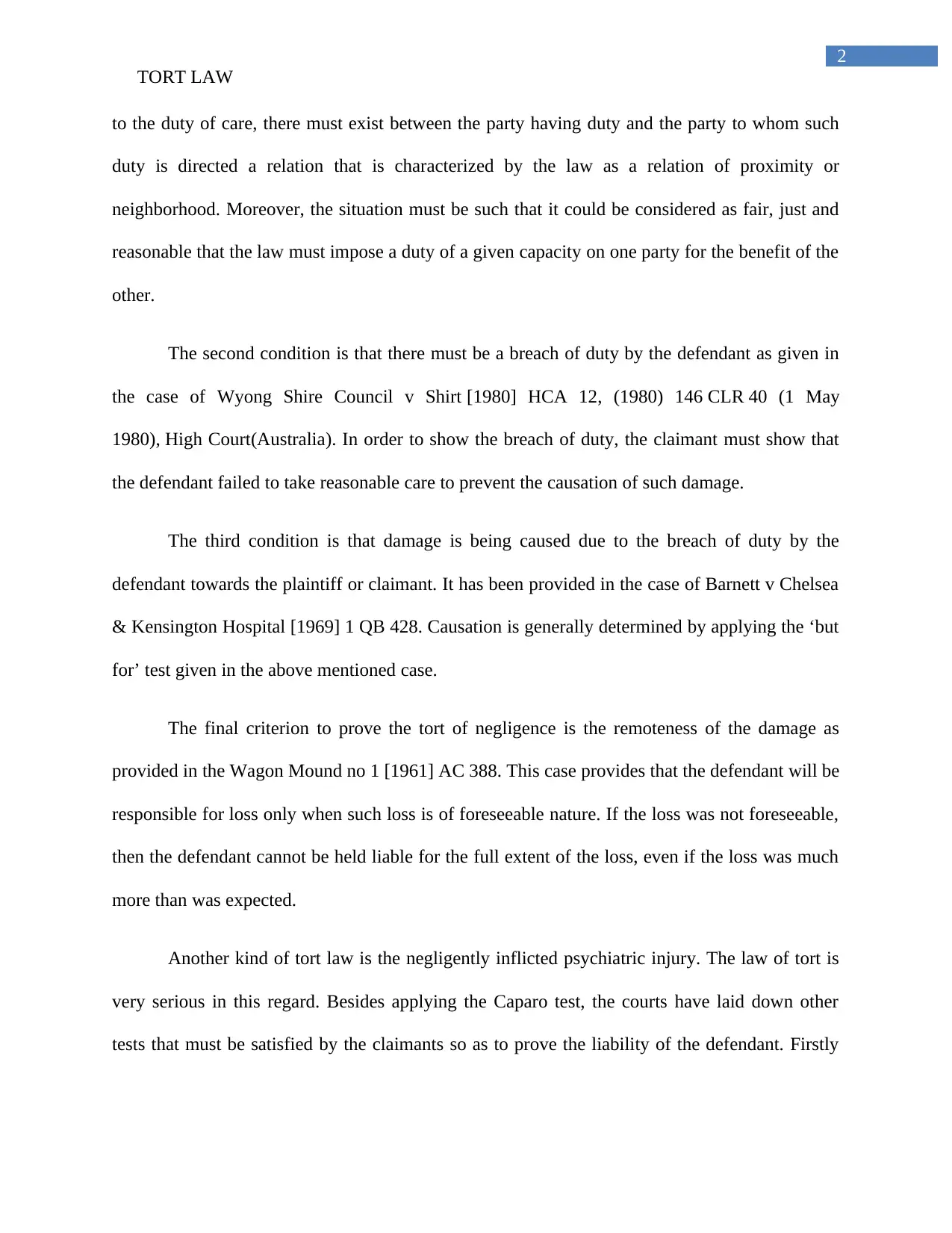
2
TORT LAW
to the duty of care, there must exist between the party having duty and the party to whom such
duty is directed a relation that is characterized by the law as a relation of proximity or
neighborhood. Moreover, the situation must be such that it could be considered as fair, just and
reasonable that the law must impose a duty of a given capacity on one party for the benefit of the
other.
The second condition is that there must be a breach of duty by the defendant as given in
the case of Wyong Shire Council v Shirt [1980] HCA 12, (1980) 146 CLR 40 (1 May
1980), High Court(Australia). In order to show the breach of duty, the claimant must show that
the defendant failed to take reasonable care to prevent the causation of such damage.
The third condition is that damage is being caused due to the breach of duty by the
defendant towards the plaintiff or claimant. It has been provided in the case of Barnett v Chelsea
& Kensington Hospital [1969] 1 QB 428. Causation is generally determined by applying the ‘but
for’ test given in the above mentioned case.
The final criterion to prove the tort of negligence is the remoteness of the damage as
provided in the Wagon Mound no 1 [1961] AC 388. This case provides that the defendant will be
responsible for loss only when such loss is of foreseeable nature. If the loss was not foreseeable,
then the defendant cannot be held liable for the full extent of the loss, even if the loss was much
more than was expected.
Another kind of tort law is the negligently inflicted psychiatric injury. The law of tort is
very serious in this regard. Besides applying the Caparo test, the courts have laid down other
tests that must be satisfied by the claimants so as to prove the liability of the defendant. Firstly
TORT LAW
to the duty of care, there must exist between the party having duty and the party to whom such
duty is directed a relation that is characterized by the law as a relation of proximity or
neighborhood. Moreover, the situation must be such that it could be considered as fair, just and
reasonable that the law must impose a duty of a given capacity on one party for the benefit of the
other.
The second condition is that there must be a breach of duty by the defendant as given in
the case of Wyong Shire Council v Shirt [1980] HCA 12, (1980) 146 CLR 40 (1 May
1980), High Court(Australia). In order to show the breach of duty, the claimant must show that
the defendant failed to take reasonable care to prevent the causation of such damage.
The third condition is that damage is being caused due to the breach of duty by the
defendant towards the plaintiff or claimant. It has been provided in the case of Barnett v Chelsea
& Kensington Hospital [1969] 1 QB 428. Causation is generally determined by applying the ‘but
for’ test given in the above mentioned case.
The final criterion to prove the tort of negligence is the remoteness of the damage as
provided in the Wagon Mound no 1 [1961] AC 388. This case provides that the defendant will be
responsible for loss only when such loss is of foreseeable nature. If the loss was not foreseeable,
then the defendant cannot be held liable for the full extent of the loss, even if the loss was much
more than was expected.
Another kind of tort law is the negligently inflicted psychiatric injury. The law of tort is
very serious in this regard. Besides applying the Caparo test, the courts have laid down other
tests that must be satisfied by the claimants so as to prove the liability of the defendant. Firstly
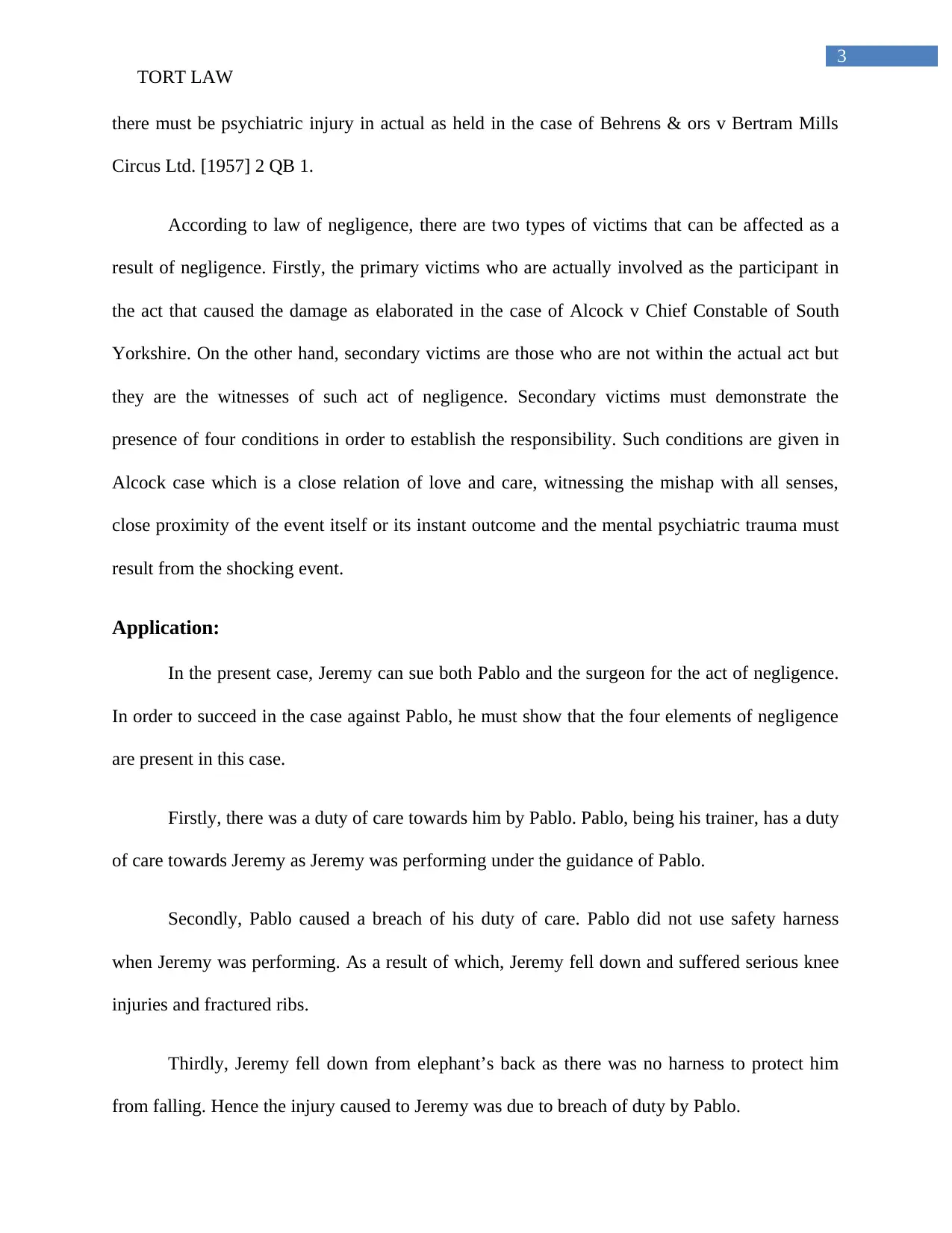
3
TORT LAW
there must be psychiatric injury in actual as held in the case of Behrens & ors v Bertram Mills
Circus Ltd. [1957] 2 QB 1.
According to law of negligence, there are two types of victims that can be affected as a
result of negligence. Firstly, the primary victims who are actually involved as the participant in
the act that caused the damage as elaborated in the case of Alcock v Chief Constable of South
Yorkshire. On the other hand, secondary victims are those who are not within the actual act but
they are the witnesses of such act of negligence. Secondary victims must demonstrate the
presence of four conditions in order to establish the responsibility. Such conditions are given in
Alcock case which is a close relation of love and care, witnessing the mishap with all senses,
close proximity of the event itself or its instant outcome and the mental psychiatric trauma must
result from the shocking event.
Application:
In the present case, Jeremy can sue both Pablo and the surgeon for the act of negligence.
In order to succeed in the case against Pablo, he must show that the four elements of negligence
are present in this case.
Firstly, there was a duty of care towards him by Pablo. Pablo, being his trainer, has a duty
of care towards Jeremy as Jeremy was performing under the guidance of Pablo.
Secondly, Pablo caused a breach of his duty of care. Pablo did not use safety harness
when Jeremy was performing. As a result of which, Jeremy fell down and suffered serious knee
injuries and fractured ribs.
Thirdly, Jeremy fell down from elephant’s back as there was no harness to protect him
from falling. Hence the injury caused to Jeremy was due to breach of duty by Pablo.
TORT LAW
there must be psychiatric injury in actual as held in the case of Behrens & ors v Bertram Mills
Circus Ltd. [1957] 2 QB 1.
According to law of negligence, there are two types of victims that can be affected as a
result of negligence. Firstly, the primary victims who are actually involved as the participant in
the act that caused the damage as elaborated in the case of Alcock v Chief Constable of South
Yorkshire. On the other hand, secondary victims are those who are not within the actual act but
they are the witnesses of such act of negligence. Secondary victims must demonstrate the
presence of four conditions in order to establish the responsibility. Such conditions are given in
Alcock case which is a close relation of love and care, witnessing the mishap with all senses,
close proximity of the event itself or its instant outcome and the mental psychiatric trauma must
result from the shocking event.
Application:
In the present case, Jeremy can sue both Pablo and the surgeon for the act of negligence.
In order to succeed in the case against Pablo, he must show that the four elements of negligence
are present in this case.
Firstly, there was a duty of care towards him by Pablo. Pablo, being his trainer, has a duty
of care towards Jeremy as Jeremy was performing under the guidance of Pablo.
Secondly, Pablo caused a breach of his duty of care. Pablo did not use safety harness
when Jeremy was performing. As a result of which, Jeremy fell down and suffered serious knee
injuries and fractured ribs.
Thirdly, Jeremy fell down from elephant’s back as there was no harness to protect him
from falling. Hence the injury caused to Jeremy was due to breach of duty by Pablo.
Secure Best Marks with AI Grader
Need help grading? Try our AI Grader for instant feedback on your assignments.
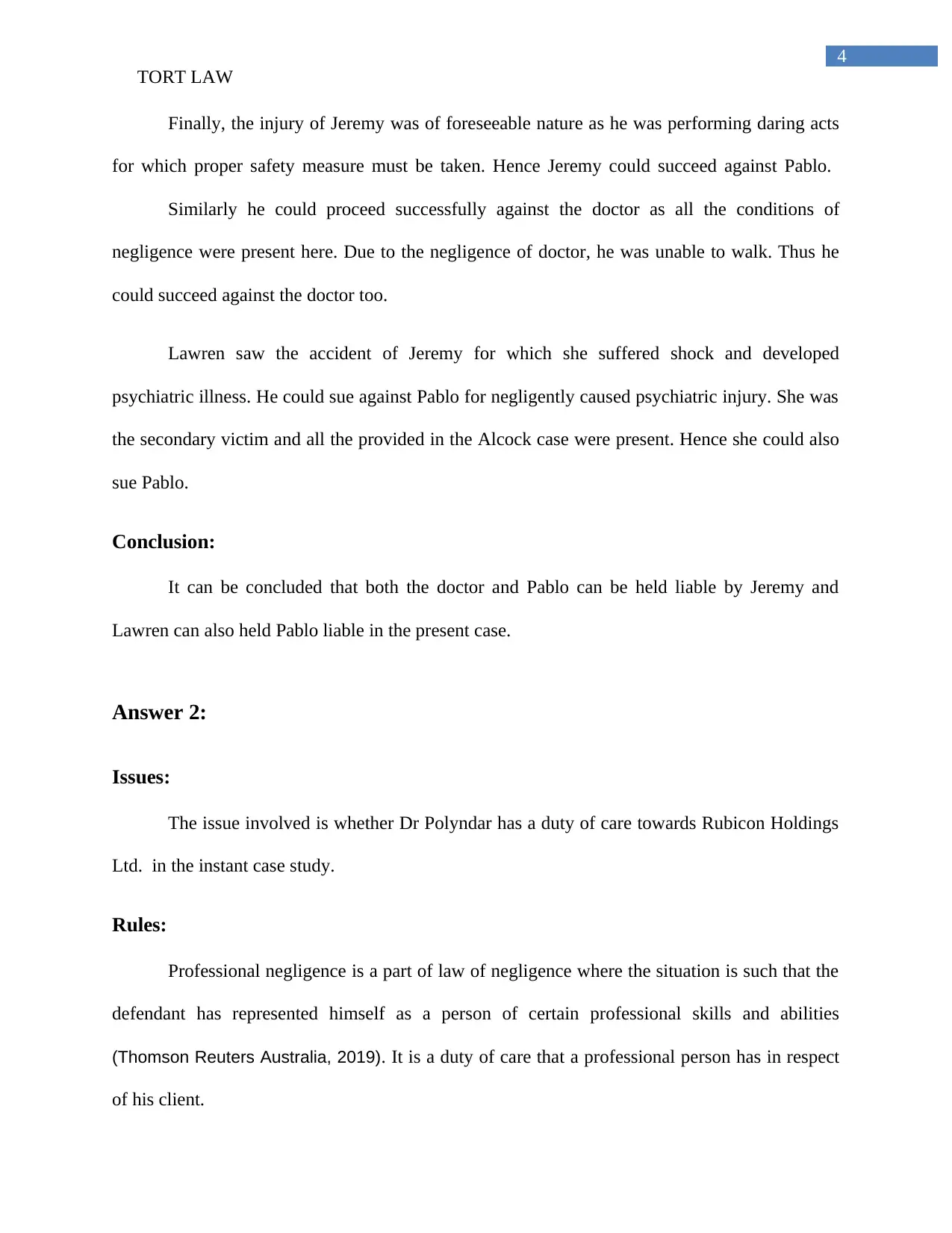
4
TORT LAW
Finally, the injury of Jeremy was of foreseeable nature as he was performing daring acts
for which proper safety measure must be taken. Hence Jeremy could succeed against Pablo.
Similarly he could proceed successfully against the doctor as all the conditions of
negligence were present here. Due to the negligence of doctor, he was unable to walk. Thus he
could succeed against the doctor too.
Lawren saw the accident of Jeremy for which she suffered shock and developed
psychiatric illness. He could sue against Pablo for negligently caused psychiatric injury. She was
the secondary victim and all the provided in the Alcock case were present. Hence she could also
sue Pablo.
Conclusion:
It can be concluded that both the doctor and Pablo can be held liable by Jeremy and
Lawren can also held Pablo liable in the present case.
Answer 2:
Issues:
The issue involved is whether Dr Polyndar has a duty of care towards Rubicon Holdings
Ltd. in the instant case study.
Rules:
Professional negligence is a part of law of negligence where the situation is such that the
defendant has represented himself as a person of certain professional skills and abilities
(Thomson Reuters Australia, 2019). It is a duty of care that a professional person has in respect
of his client.
TORT LAW
Finally, the injury of Jeremy was of foreseeable nature as he was performing daring acts
for which proper safety measure must be taken. Hence Jeremy could succeed against Pablo.
Similarly he could proceed successfully against the doctor as all the conditions of
negligence were present here. Due to the negligence of doctor, he was unable to walk. Thus he
could succeed against the doctor too.
Lawren saw the accident of Jeremy for which she suffered shock and developed
psychiatric illness. He could sue against Pablo for negligently caused psychiatric injury. She was
the secondary victim and all the provided in the Alcock case were present. Hence she could also
sue Pablo.
Conclusion:
It can be concluded that both the doctor and Pablo can be held liable by Jeremy and
Lawren can also held Pablo liable in the present case.
Answer 2:
Issues:
The issue involved is whether Dr Polyndar has a duty of care towards Rubicon Holdings
Ltd. in the instant case study.
Rules:
Professional negligence is a part of law of negligence where the situation is such that the
defendant has represented himself as a person of certain professional skills and abilities
(Thomson Reuters Australia, 2019). It is a duty of care that a professional person has in respect
of his client.
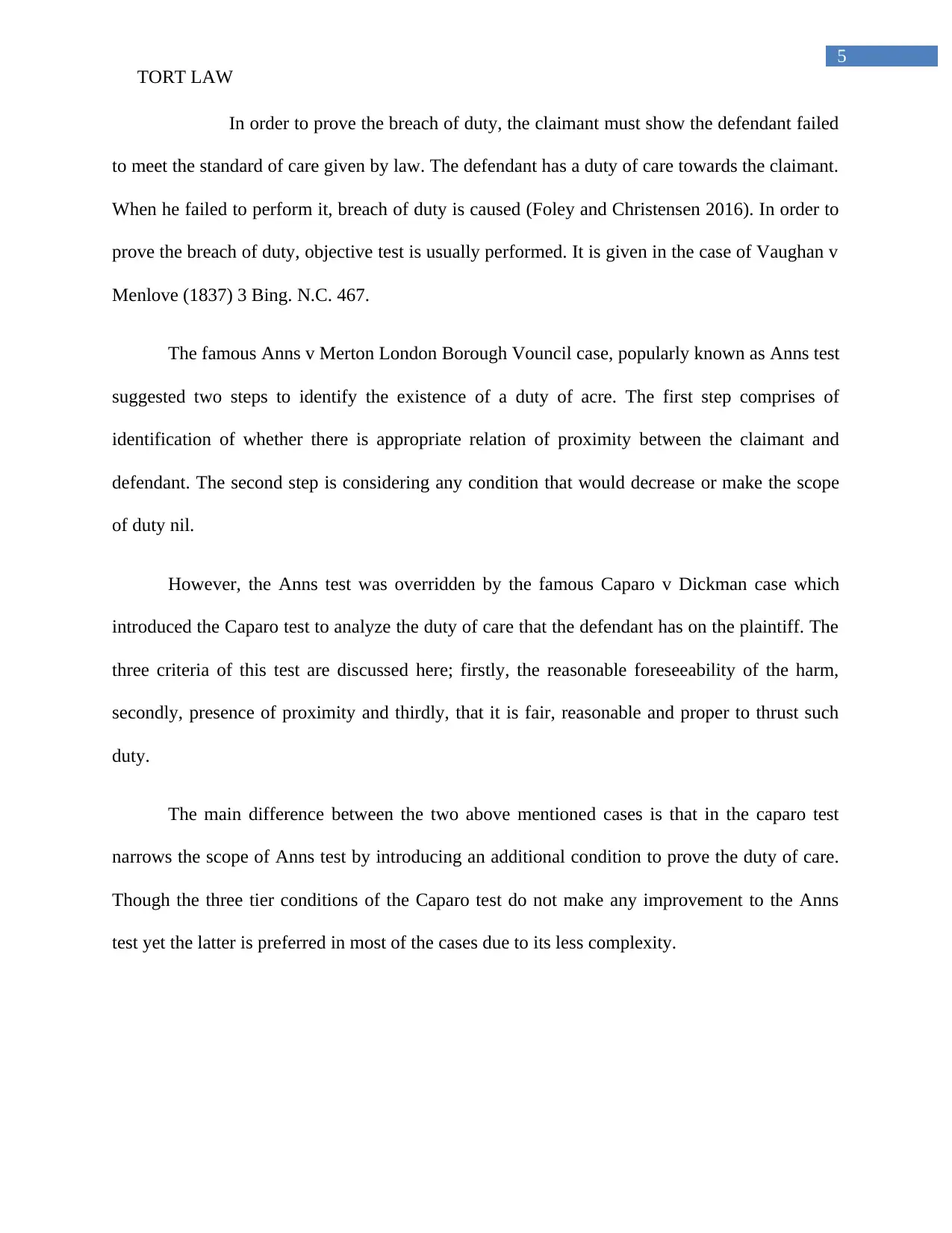
5
TORT LAW
In order to prove the breach of duty, the claimant must show the defendant failed
to meet the standard of care given by law. The defendant has a duty of care towards the claimant.
When he failed to perform it, breach of duty is caused (Foley and Christensen 2016). In order to
prove the breach of duty, objective test is usually performed. It is given in the case of Vaughan v
Menlove (1837) 3 Bing. N.C. 467.
The famous Anns v Merton London Borough Vouncil case, popularly known as Anns test
suggested two steps to identify the existence of a duty of acre. The first step comprises of
identification of whether there is appropriate relation of proximity between the claimant and
defendant. The second step is considering any condition that would decrease or make the scope
of duty nil.
However, the Anns test was overridden by the famous Caparo v Dickman case which
introduced the Caparo test to analyze the duty of care that the defendant has on the plaintiff. The
three criteria of this test are discussed here; firstly, the reasonable foreseeability of the harm,
secondly, presence of proximity and thirdly, that it is fair, reasonable and proper to thrust such
duty.
The main difference between the two above mentioned cases is that in the caparo test
narrows the scope of Anns test by introducing an additional condition to prove the duty of care.
Though the three tier conditions of the Caparo test do not make any improvement to the Anns
test yet the latter is preferred in most of the cases due to its less complexity.
TORT LAW
In order to prove the breach of duty, the claimant must show the defendant failed
to meet the standard of care given by law. The defendant has a duty of care towards the claimant.
When he failed to perform it, breach of duty is caused (Foley and Christensen 2016). In order to
prove the breach of duty, objective test is usually performed. It is given in the case of Vaughan v
Menlove (1837) 3 Bing. N.C. 467.
The famous Anns v Merton London Borough Vouncil case, popularly known as Anns test
suggested two steps to identify the existence of a duty of acre. The first step comprises of
identification of whether there is appropriate relation of proximity between the claimant and
defendant. The second step is considering any condition that would decrease or make the scope
of duty nil.
However, the Anns test was overridden by the famous Caparo v Dickman case which
introduced the Caparo test to analyze the duty of care that the defendant has on the plaintiff. The
three criteria of this test are discussed here; firstly, the reasonable foreseeability of the harm,
secondly, presence of proximity and thirdly, that it is fair, reasonable and proper to thrust such
duty.
The main difference between the two above mentioned cases is that in the caparo test
narrows the scope of Anns test by introducing an additional condition to prove the duty of care.
Though the three tier conditions of the Caparo test do not make any improvement to the Anns
test yet the latter is preferred in most of the cases due to its less complexity.
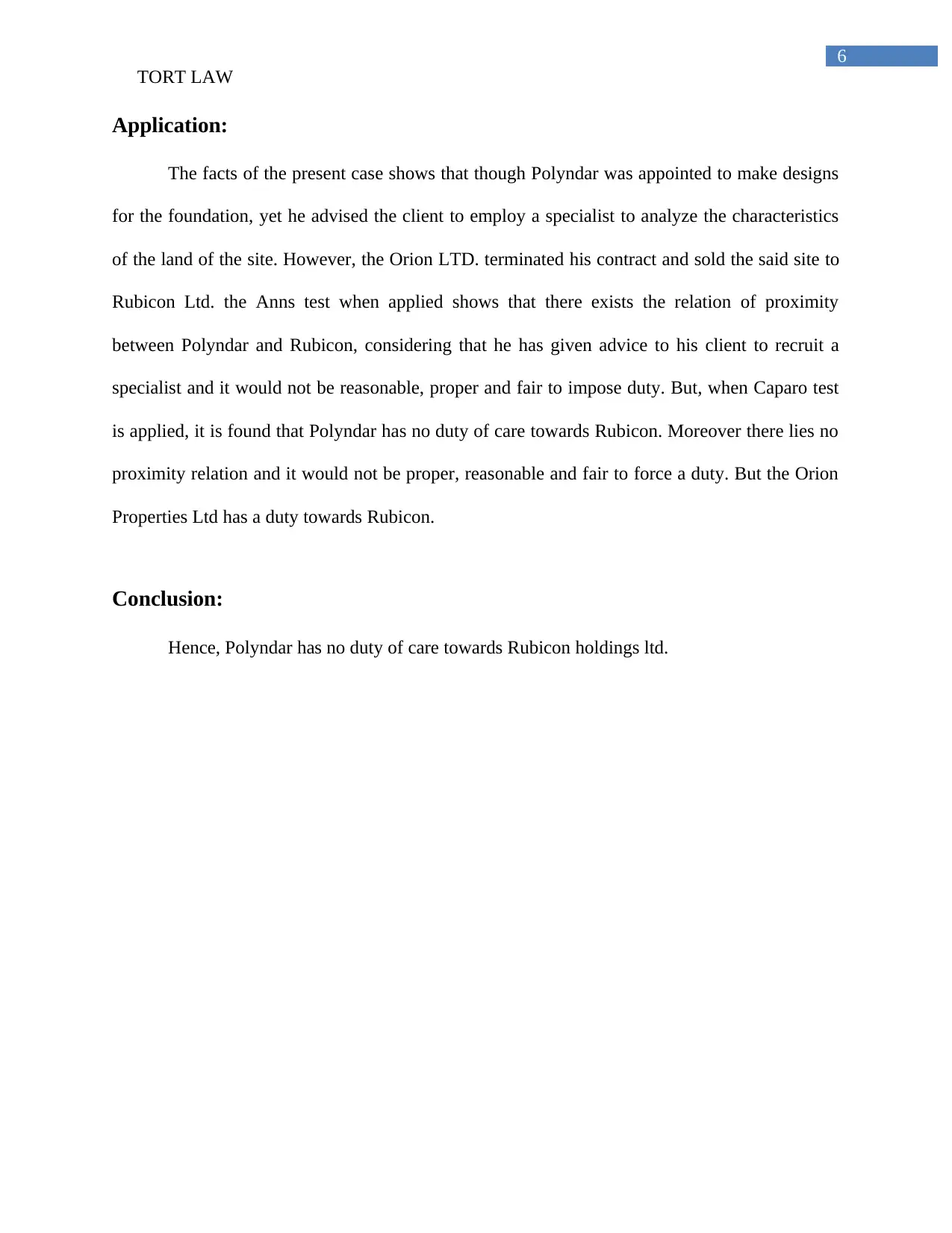
6
TORT LAW
Application:
The facts of the present case shows that though Polyndar was appointed to make designs
for the foundation, yet he advised the client to employ a specialist to analyze the characteristics
of the land of the site. However, the Orion LTD. terminated his contract and sold the said site to
Rubicon Ltd. the Anns test when applied shows that there exists the relation of proximity
between Polyndar and Rubicon, considering that he has given advice to his client to recruit a
specialist and it would not be reasonable, proper and fair to impose duty. But, when Caparo test
is applied, it is found that Polyndar has no duty of care towards Rubicon. Moreover there lies no
proximity relation and it would not be proper, reasonable and fair to force a duty. But the Orion
Properties Ltd has a duty towards Rubicon.
Conclusion:
Hence, Polyndar has no duty of care towards Rubicon holdings ltd.
TORT LAW
Application:
The facts of the present case shows that though Polyndar was appointed to make designs
for the foundation, yet he advised the client to employ a specialist to analyze the characteristics
of the land of the site. However, the Orion LTD. terminated his contract and sold the said site to
Rubicon Ltd. the Anns test when applied shows that there exists the relation of proximity
between Polyndar and Rubicon, considering that he has given advice to his client to recruit a
specialist and it would not be reasonable, proper and fair to impose duty. But, when Caparo test
is applied, it is found that Polyndar has no duty of care towards Rubicon. Moreover there lies no
proximity relation and it would not be proper, reasonable and fair to force a duty. But the Orion
Properties Ltd has a duty towards Rubicon.
Conclusion:
Hence, Polyndar has no duty of care towards Rubicon holdings ltd.
Paraphrase This Document
Need a fresh take? Get an instant paraphrase of this document with our AI Paraphraser
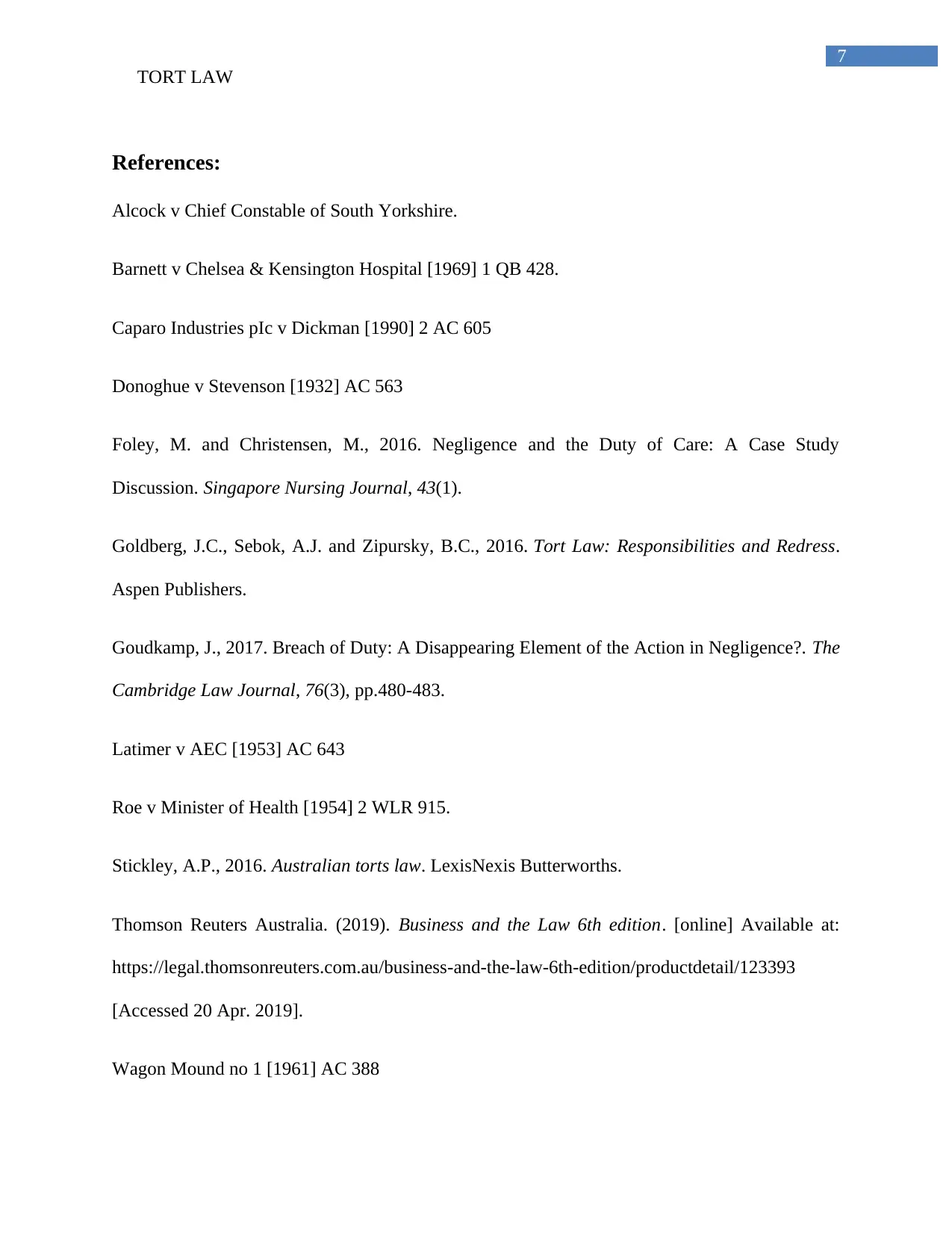
7
TORT LAW
References:
Alcock v Chief Constable of South Yorkshire.
Barnett v Chelsea & Kensington Hospital [1969] 1 QB 428.
Caparo Industries pIc v Dickman [1990] 2 AC 605
Donoghue v Stevenson [1932] AC 563
Foley, M. and Christensen, M., 2016. Negligence and the Duty of Care: A Case Study
Discussion. Singapore Nursing Journal, 43(1).
Goldberg, J.C., Sebok, A.J. and Zipursky, B.C., 2016. Tort Law: Responsibilities and Redress.
Aspen Publishers.
Goudkamp, J., 2017. Breach of Duty: A Disappearing Element of the Action in Negligence?. The
Cambridge Law Journal, 76(3), pp.480-483.
Latimer v AEC [1953] AC 643
Roe v Minister of Health [1954] 2 WLR 915.
Stickley, A.P., 2016. Australian torts law. LexisNexis Butterworths.
Thomson Reuters Australia. (2019). Business and the Law 6th edition. [online] Available at:
https://legal.thomsonreuters.com.au/business-and-the-law-6th-edition/productdetail/123393
[Accessed 20 Apr. 2019].
Wagon Mound no 1 [1961] AC 388
TORT LAW
References:
Alcock v Chief Constable of South Yorkshire.
Barnett v Chelsea & Kensington Hospital [1969] 1 QB 428.
Caparo Industries pIc v Dickman [1990] 2 AC 605
Donoghue v Stevenson [1932] AC 563
Foley, M. and Christensen, M., 2016. Negligence and the Duty of Care: A Case Study
Discussion. Singapore Nursing Journal, 43(1).
Goldberg, J.C., Sebok, A.J. and Zipursky, B.C., 2016. Tort Law: Responsibilities and Redress.
Aspen Publishers.
Goudkamp, J., 2017. Breach of Duty: A Disappearing Element of the Action in Negligence?. The
Cambridge Law Journal, 76(3), pp.480-483.
Latimer v AEC [1953] AC 643
Roe v Minister of Health [1954] 2 WLR 915.
Stickley, A.P., 2016. Australian torts law. LexisNexis Butterworths.
Thomson Reuters Australia. (2019). Business and the Law 6th edition. [online] Available at:
https://legal.thomsonreuters.com.au/business-and-the-law-6th-edition/productdetail/123393
[Accessed 20 Apr. 2019].
Wagon Mound no 1 [1961] AC 388
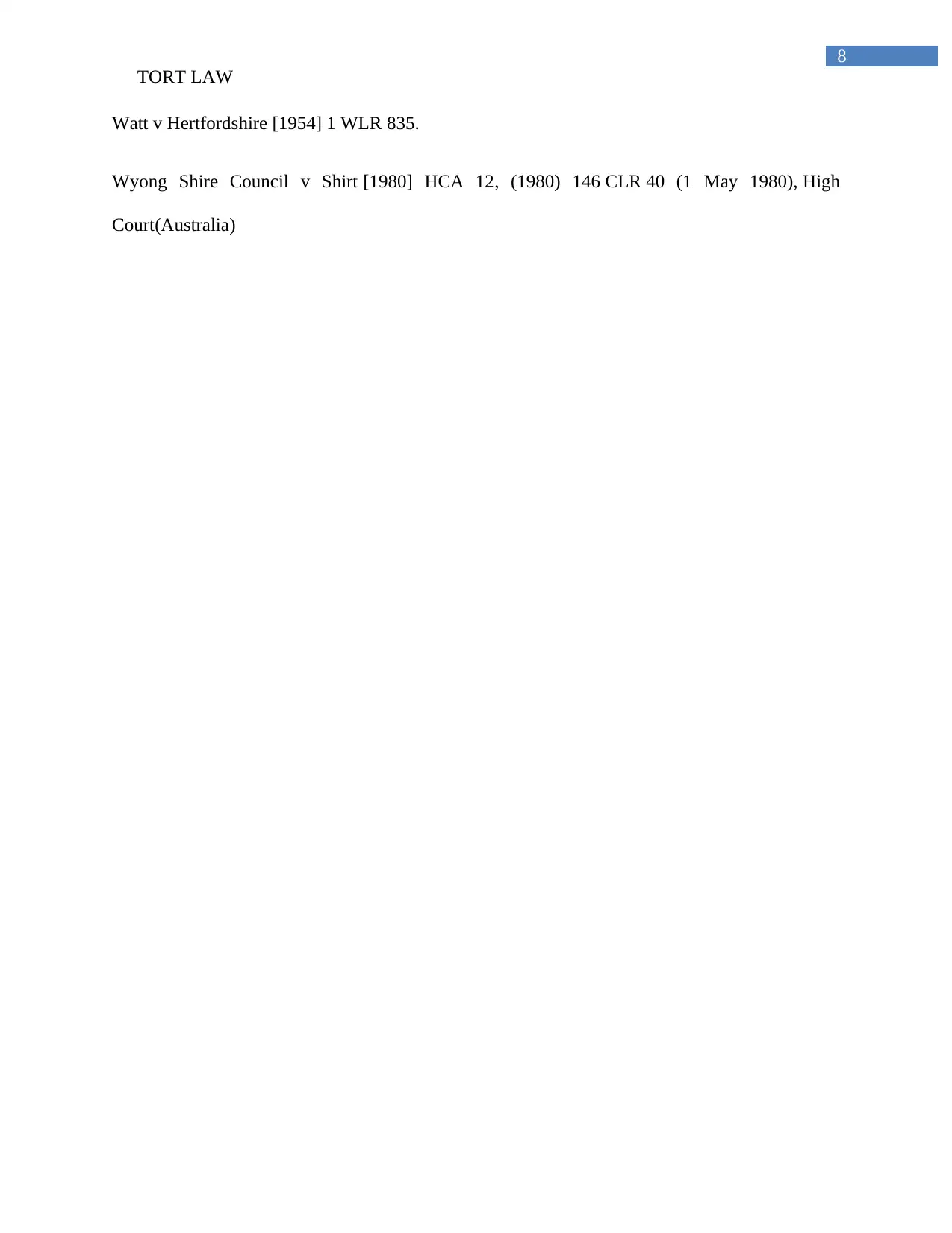
8
TORT LAW
Watt v Hertfordshire [1954] 1 WLR 835.
Wyong Shire Council v Shirt [1980] HCA 12, (1980) 146 CLR 40 (1 May 1980), High
Court(Australia)
TORT LAW
Watt v Hertfordshire [1954] 1 WLR 835.
Wyong Shire Council v Shirt [1980] HCA 12, (1980) 146 CLR 40 (1 May 1980), High
Court(Australia)
1 out of 9
Related Documents
Your All-in-One AI-Powered Toolkit for Academic Success.
+13062052269
info@desklib.com
Available 24*7 on WhatsApp / Email
![[object Object]](/_next/static/media/star-bottom.7253800d.svg)
Unlock your academic potential
© 2024 | Zucol Services PVT LTD | All rights reserved.





